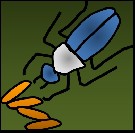In the inland valleys in Sub-Saharan Africa, African rice gall midge (Orseolia oryzivora Harris and Gagné) causes significant damage. During its life-cycle, it completes four stages:
The egg is elongated and about 0.45 mm long, has a brilliant white color, which becomes yellow then amber with red dots before hatching (when the larva leaves the egg);
The larva is whitish with two pairs of spines at the abdomen disappearing at the end of the larval stage, when the larva becomes milky white and the mouth spirals become brown;
The pupa (female gall midge 5 mm) is pale pink except for the wing buds. The legs, eyes and antennae become brown first, well before emergence. The leg buds are detached from the abdomen, the back-end segments have rows of strong spines bent backwards;
The adult: a rice gall midge is the size of a mosquito (4.8 mm long), is reddish with dark antennae and thorax, and black eyes.
Biology and damage
The adult often enters the rice field unnoticed. It lives 2 to 4 days. The female lays 200 to 400 eggs, individually or in groups of 3 to 5 on the stem base, on the ligules or in the vicinity, on the underside of the leaf sheath or even on the surface of the water. Incubation takes 2 to 5 days.
At hatching, the larva makes its way down between the leaf sheaths and the stem to the growing point (apical meristem), and then penetrates into the tiller. The larva causes the plant to form a tubular, hollow gall at the tiller’s growing point, within which it stays its whole life. In each gall there is one larva. The gall develops on young tillers, before distinct internodes can be observed. The gall is formed by a bulbous thickening at the growing point which is destroyed and which is followed by a tubular, hollow, very long part, pearly white so that the plant looks like an onion leaf.
After two weeks, the larva is transformed into a pupa (cocoon). The pupa is mobile. Towards the end of the pupal stage (after one week) it moves upwards inside the gall tube to about one third from the tip of the gall. Here it cuts a hole in the wall and the adult midge emerges and crawls out leaving the pupal skin protruding from the exit hole.
Recognizing gall midge damage
Each ‘onion leaf’ is a lost stem. After the emergence of the adult, the ‘onion leaves’ become yellow, then dry; after which further elongation is impossible. The plant reacts by producing new tillers, which are often infested too.
Orseolia oryzivora can proliferate locally for years, or when two rice crops a year are cultivated. Every year the midge is found at certain locations, but the particular conditions ideal for attack are poorly defined. Only rice fields at tillering stage can be infested. The younger the plant at the time of attack (28 to 42 days after transplanting), the worse the infestation. .
The generations succeed one another and grow from the beginning of the rainy season. High relative humidity (more than 50%) favors egg laying and incubation.
Gall midge survives on cultivated-rice ratoons or on wild grasses, namely wild rices (Oryza barthii, O. longistaminata see Figures 22.1 and 22.2), Ischaemun sp., and Echinochloa colona. In a dormant state, galls are bulbous, half buried in the ground, and the exterior part is a rather short tube. Infestation is most severe when rains are early and followed by a dry period delaying transplanting or sowing. A first infestation then builds up on weeds and when rice grows, it is immediately severely infested. A second rice crop can still be severely attacked at the beginning of the dry season in irrigated regions.
Extract from PLAR-IRM Curriculum: Technical Manual (Wopereis et al., 2009)













